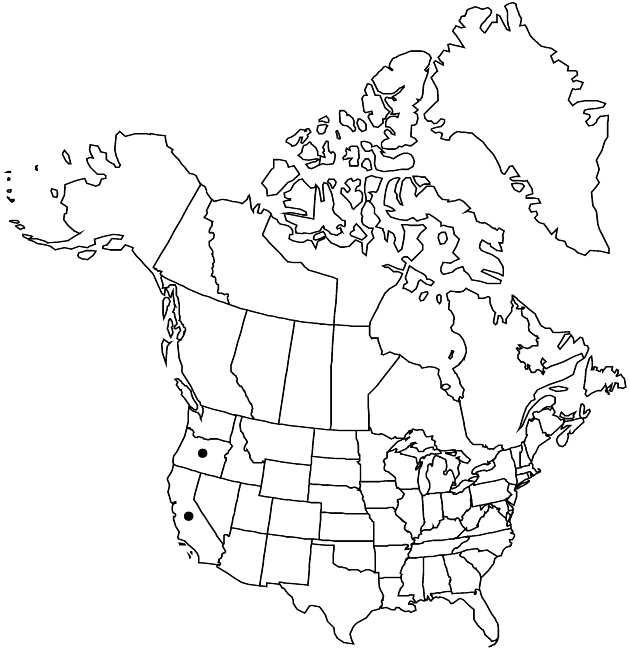Difference between revisions of "Micropus californicus"
Index Seminum (St. Petersburg) 2: 42. 1836.
FNA>Volume Importer |
FNA>Volume Importer |
||
| Line 12: | Line 12: | ||
|name=Bombycilaena californica | |name=Bombycilaena californica | ||
|authority=(Fischer & C. A. Meyer) Holub | |authority=(Fischer & C. A. Meyer) Holub | ||
| + | |rank=species | ||
}} | }} | ||
|hierarchy=Asteraceae;Asteraceae tribe Gnaphalieae;Micropus;Micropus californicus | |hierarchy=Asteraceae;Asteraceae tribe Gnaphalieae;Micropus;Micropus californicus | ||
| Line 26: | Line 27: | ||
|discussion=<p>Varieties 2 (2 in the flora).</p><!-- | |discussion=<p>Varieties 2 (2 in the flora).</p><!-- | ||
--><p>Though common and often found on recent disturbances within its range, <i>Micropus californicus</i> does not appear to be particularly invasive or weedy. The mature pistillate paleae, with roughly the profile of a harp or of an inverted lower-case letter “q,” are distinctive. That shape and the accompanying dense, cottony indument of the common variety explain the vernacular names. By contrast, pistillate paleae of <i>M. amphibolus</i> have roughly the profile of a human head wearing a billed cap.</p><!-- | --><p>Though common and often found on recent disturbances within its range, <i>Micropus californicus</i> does not appear to be particularly invasive or weedy. The mature pistillate paleae, with roughly the profile of a harp or of an inverted lower-case letter “q,” are distinctive. That shape and the accompanying dense, cottony indument of the common variety explain the vernacular names. By contrast, pistillate paleae of <i>M. amphibolus</i> have roughly the profile of a human head wearing a billed cap.</p><!-- | ||
| − | --><p>Within the more limited range of < | + | --><p>Within the more limited range of <i></i>var.<i> subvestitus</i>, the two varieties are broadly sympatric, usually in separate populations, occasionally in mixed populations that sometimes include intermediate plants.</p> |
|tables= | |tables= | ||
|references= | |references= | ||
| Line 49: | Line 50: | ||
-->{{#Taxon: | -->{{#Taxon: | ||
name=Micropus californicus | name=Micropus californicus | ||
| − | |||
|authority=Fischer & C. A. Meyer | |authority=Fischer & C. A. Meyer | ||
|rank=species | |rank=species | ||
| Line 61: | Line 61: | ||
|publication year=1836 | |publication year=1836 | ||
|special status= | |special status= | ||
| − | |source xml=https://jpend@bitbucket.org/aafc-mbb/fna-data-curation.git/src/ | + | |source xml=https://jpend@bitbucket.org/aafc-mbb/fna-data-curation.git/src/eaa6e58056e40c9ef614d8f47aea294977a1a5e9/coarse_grained_fna_xml/V19-20-21/V19_755.xml |
|tribe=Asteraceae tribe Gnaphalieae | |tribe=Asteraceae tribe Gnaphalieae | ||
|genus=Micropus | |genus=Micropus | ||
Revision as of 20:21, 16 December 2019
Plants 1–50 cm. Heads depressed-spheric, 2–4 × 3–6 mm. Receptacles depressed-spheric, mostly 0.3–0.6 mm, heights 0.5–0.8 times diams. Pistillate paleae 4–7(–8) in 1 series, longest 2–4 mm; wings obscure, withering, lateral, ± erect, narrowly oblanceolate, involute; bodies galeate, cartilaginous to bony throughout, sericeous to lanuginose. Staminate paleae 0. Staminate corollas 1–2 mm, lobes usually 5. Cypselae 1.4–2.6 mm, corolla scars ± median; pappi: staminate 0 or of 1, ± smooth bristle 0.9–1.5 mm.
Distribution

w United States, nw Mexico.
Discussion
Varieties 2 (2 in the flora).
Though common and often found on recent disturbances within its range, Micropus californicus does not appear to be particularly invasive or weedy. The mature pistillate paleae, with roughly the profile of a harp or of an inverted lower-case letter “q,” are distinctive. That shape and the accompanying dense, cottony indument of the common variety explain the vernacular names. By contrast, pistillate paleae of M. amphibolus have roughly the profile of a human head wearing a billed cap.
Within the more limited range of var. subvestitus, the two varieties are broadly sympatric, usually in separate populations, occasionally in mixed populations that sometimes include intermediate plants.
Selected References
None.
Key
| 1 | Pistillate paleae densely and loosely lanuginose, longest usually 3–4 mm | Micropus californicus var. californicus |
| 1 | Pistillate paleae thinly sericeous-lanuginose, longest usually 2–3 mm | Micropus californicus var. subvestitus |